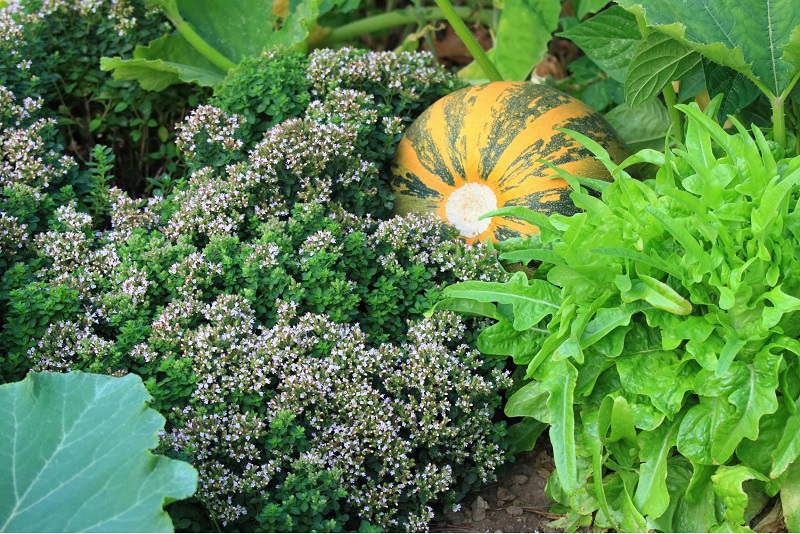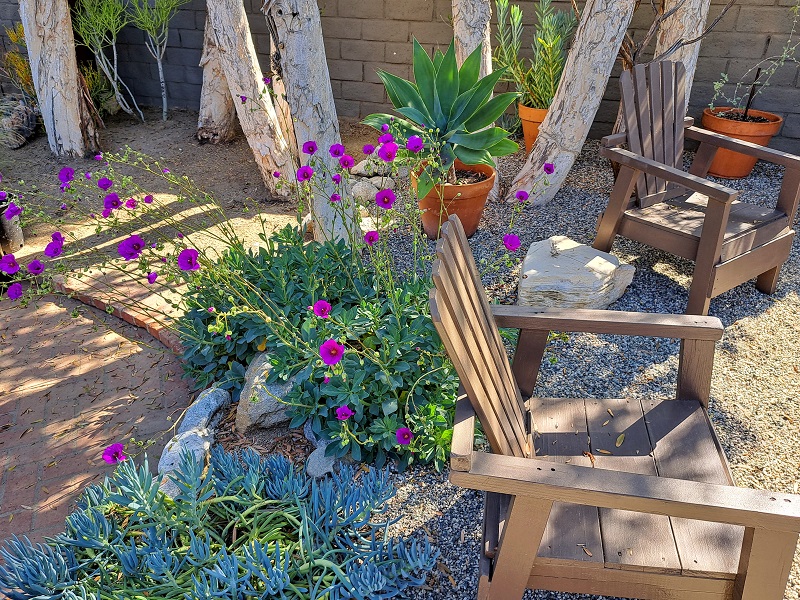If you desire a sustainable garden or yard that can essentially take care of itself, you’ll definitely want to try your hand at permaculture.
Permaculture is all about designing landscapes that work with nature rather than against it. This type of yard is able to produce food, medicine, and resources, while supporting biodiversity through pollination, and other forms of productive interaction between flora and fauna.
With proper planning, anyone can transform their backyard into a magical symbiotic ecosystem that’s enjoyable to experience and healthy for your local environment.
Table of Contents
Also see:
- How to Create a Thriving Pollinator Garden with These Plants & Trees
- How to Design a Low-Maintenance Garden in 5 Simple Steps
- Dirt Locker: DIY Sustainable Erosion Control Landscaping
- More Recommended Landscaping & Gardening Articles
- Related Topics: Gardening | Landscaping | Lawn Care | Smart Irrigation
What is a Permaculture Yard?
A permaculture yard is a sustainable outdoor space that utilizes natural patterns and processes to create a self-sufficient ecosystem.
The practice of permaculture involves designing a yard to mimic the natural environment, allowing plants, animals, and insects to interact with each other harmoniously. The main aim of creating a permaculture yard is to ensure that all components of a “micro-ecosystem” work together seamlessly and symbiotically, without human intervention.
Fun Fact:
The word Permaculture is a portmanteau (a blending of two words) from the combination of Permanent Agriculture and Permanent Culture that was originally coined by Australian Environmental Researchers Bill Mollison and David Holmgren in 1978.
One of the principles of permaculture design is diversity. Instead of planting only one type of crop, you can plant different crops that complement each other. This can benefit the health of all of your plants and increase the odds that you’ll have a good harvest. You can further incorporate different types of trees and shrubs into your yard to attract beneficial insects and birds.

The Three Sisters (corn, beans, and squash) are a classic example of symbiotic agriculture (AKA companion planting) practiced and perfected by indigenous peoples throughout the Americas.

Illustration of the Three Sisters symbiotic system of planting corn, beans, and squash crops together.
Image courtesy of FreshPoint
The Three Sisters system works as follows:
- The corn stalk serves as a pole for the bean vines to climb
- The bean vines support the corn by adding nitrogen back into the soil
- The squash leaves serve as a protective mulch which retains moisture while blocking weeds
This form of agriculture is also referred to as regenerative agricultural, and relates to the practice of intercropping and polycultures.
Another key example that will help you conceptualize this type of garden is planting perennials that naturally fertilize the soil while attracting pollinating insects and detering pests.
5 Steps to Designing a Permaculture Backyard
- Research Local Native Plants
- Decide How & Where You Want to Plant
- Collect Natural Resources
- Minimize Maintenance
- Set a Goal of Having a Productive, Beautiful & Enjoyable Yard
1. Research Local Native Plants
Just like when planning a xeriscape and other landscaping types, the first step of creating a permaculture yard is finding plants that will grow well on your property.
Native plants naturally occur in a specific geographic region and have adapted over long periods of time to the local soil, climate and wildlife. They require less maintenance than non-native species and provide food and shelter for local wildlife.

Researching native plants involves learning about the flora of your region, including trees, shrubs, perennials and groundcovers. To identify native species, you can visit a local nature center or consult field guides and online resources.
When choosing plants for your yard, consider their:
- Growth Habits (Size and Shape)
- Bloom Time
- Color Scheme, and
- Texture
Once you’ve identified some suitable native plants for your yard, start looking into the right location for each species based on its sunlight and other requirements. By matching each plant with its ideal growing conditions in your yard plan, you’ll create a thriving ecosystem without relying on synthetic fertilizers or pesticides.

2. Decide How & Where You Want to Plant
Deciding how and where to place your plants is crucial for creating a thriving, sustainable ecosystem.
One option is to use raised beds. Raised beds provide the following benefits:
- Provide better drainage
- Warm faster, and
- Help you get around poor ground soil quality

However, raised beds require more initial work to set up, and will eventually require repairs.
Another option is in-ground planting. This method allows for more flexibility in planting location and doesn’t involve any building. On the downside, you may need to work on bringing the soil up to quality, and it’s typically easier for weeds and pests to reach in-ground plants.
There are also several more points to consider when thinking of where to put your plants, including:
- Consider using companion planting techniques to maximize space and promote natural pest control
- Note any existing structures or features in your backyard when deciding where to plant
- Plan for future growth by leaving enough space between plants so they can expand without overcrowding

Here are a few design services and tools that may help you conceptualize and prioritize what you may want in your permaculture garden or yard:
- Home Outside Virtual Designs for Sustainable Gardens
- Tomate & Basilic: Permaculture Gardening App (Apple App Store)
- Tomate & Basilic: Permaculture Gardening App (Google Play)
- Permaculture Property Digital Toolkit from Verge Permaculture
- More Companies that Offer Virtual Landscaping & Garden Design Services
3. Collect Natural Resources
To make the most of a permaculture backyard, set up ways to collect resources like rainwater and compost.
Using containers or barrels, you can easily gather these valuable and “virtually free” resources to nourish your plants and soil.
Rainwater collection is simple and effective. Place a large container where rainwater runoff will flow into it naturally, such as under a downspout or near a low-lying area of your yard. You can then use this collection to water your plants during dry spells, saving money along the way.

Composting is another important resource for any permaculture garden. Creating a compost pile allows you to turn organic waste like food scraps and yard trimmings into nutrient-rich soil amendments.

Also see:
4. Minimize Maintenance
Another principle of permaculture is reducing the amount of upkeep you have to do.
An easy way to achieve this, as mentioned earlier, is by selecting low-maintenance plants well-suited for your specific climate and soil conditions. Native plants often require less water and fertilizer than non-native species, helping create a self-sustaining garden that requires minimal intervention.

Another way to minimize garden maintenance is by incorporating companion planting techniques. These can help reduce pest problems naturally without harsh chemicals or constant monitoring.
Lastly, you can consider removing some of your lawn. Mowing, edging, and watering the grass can take a lot of time and resources. Instead, you can use the space for more plantings that naturally produce more, and require less work from you.
5. Set a Goal of Having a Productive, Beautiful & Enjoyable Yard
For a backyard that benefits your local environment and makes things easier on you, designing a permaculture backyard is a great way to go. Making sure you choose the right plants, having systems in place to collect natural resources, and reducing your need to tend to the yard are all ways to make the most of permaculture principles. By following these tips, you can have a yard that’s productive, beautiful and quite enjoyable!
Permaculture Resources
- Permaculture Wikipedia Page
- Permaculture Research Institute (PRI)
- Permaculture Institute of North America (PINA)
- Permaculture Books on Amazon
- Permaculture Design Certificate Course Oregon State University
- World Permaculture Association
- PermacultureGardens.org
- Backyard Permaculture Guild
More Recommended Landscaping & Gardening Articles
- Best Fruit Trees to Plant by Hardiness Zone
- How to Add Calm to Your Life with a Peaceful Sensory Garden
- Firescaping: How to Protect Your Home with Fire Resistant Landscapes
- The Traits & Risks of Dangerous Trees: Is Your Property Safe?
- Uber Apps for Lawn Care & Outdoor Services
- Best Garden & Landscaping Shows Now on Amazon Prime
- Pestie: The 411 on the Popular DIY Pest Control Subscription Service
- Pet Waste Removal: An Invaluable Healthy Home Service for Homeowners
- Related Topics: Gardening | Landscaping | Lawn Care | Home Wellness
| Purgula is reader-supported. When you click on links to other sites from our website, we may earn affiliate commissions, at no cost to you. If you find our content to be helpful, this is an easy way for you to support our mission. Thanks! Learn more. |







